Analysis of Lipton Company in UK Market
VerifiedAdded on 2023/05/28
|13
|3037
|302
AI Summary
This report analyzes the Lipton Company in the UK market, including PESTLE and Porter five force models, market strategies, SWOT analysis, and product life cycle. Recommendations are made based on the analysis.
Contribute Materials
Your contribution can guide someone’s learning journey. Share your
documents today.

Business management with marketing
Secure Best Marks with AI Grader
Need help grading? Try our AI Grader for instant feedback on your assignments.
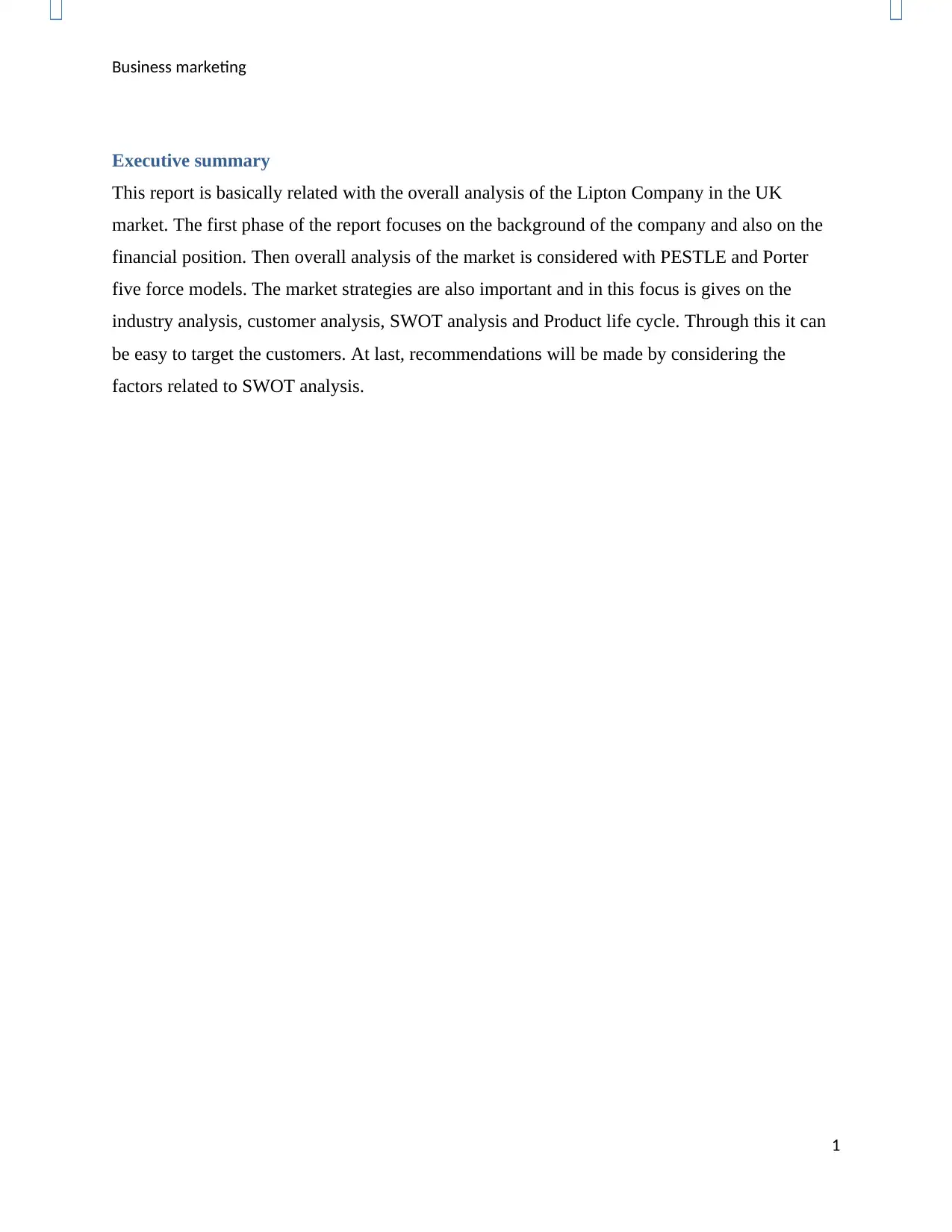
Business marketing
Executive summary
This report is basically related with the overall analysis of the Lipton Company in the UK
market. The first phase of the report focuses on the background of the company and also on the
financial position. Then overall analysis of the market is considered with PESTLE and Porter
five force models. The market strategies are also important and in this focus is gives on the
industry analysis, customer analysis, SWOT analysis and Product life cycle. Through this it can
be easy to target the customers. At last, recommendations will be made by considering the
factors related to SWOT analysis.
1
Executive summary
This report is basically related with the overall analysis of the Lipton Company in the UK
market. The first phase of the report focuses on the background of the company and also on the
financial position. Then overall analysis of the market is considered with PESTLE and Porter
five force models. The market strategies are also important and in this focus is gives on the
industry analysis, customer analysis, SWOT analysis and Product life cycle. Through this it can
be easy to target the customers. At last, recommendations will be made by considering the
factors related to SWOT analysis.
1
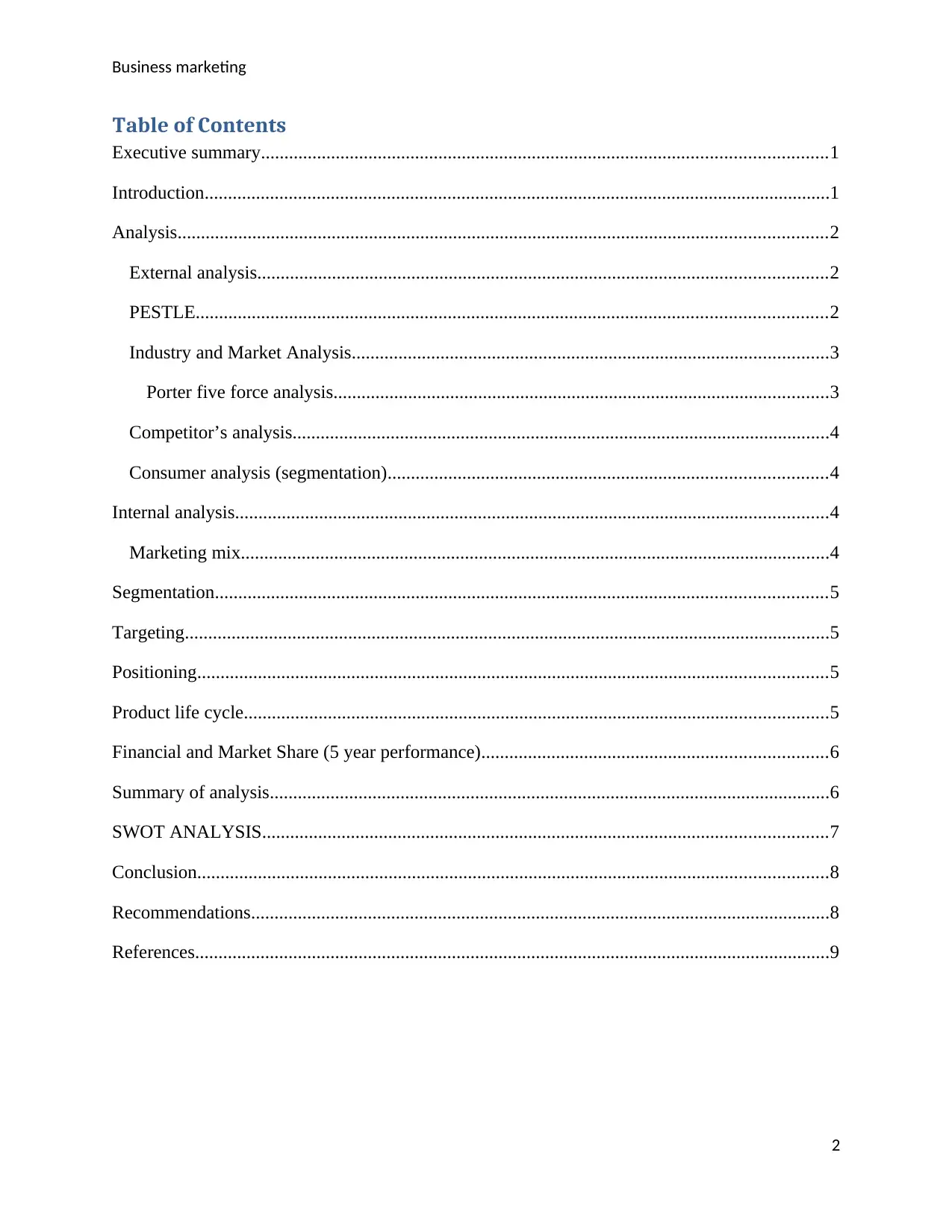
Business marketing
Table of Contents
Executive summary.........................................................................................................................1
Introduction......................................................................................................................................1
Analysis...........................................................................................................................................2
External analysis..........................................................................................................................2
PESTLE.......................................................................................................................................2
Industry and Market Analysis......................................................................................................3
Porter five force analysis..........................................................................................................3
Competitor’s analysis...................................................................................................................4
Consumer analysis (segmentation)..............................................................................................4
Internal analysis...............................................................................................................................4
Marketing mix..............................................................................................................................4
Segmentation...................................................................................................................................5
Targeting..........................................................................................................................................5
Positioning.......................................................................................................................................5
Product life cycle.............................................................................................................................5
Financial and Market Share (5 year performance)..........................................................................6
Summary of analysis........................................................................................................................6
SWOT ANALYSIS.........................................................................................................................7
Conclusion.......................................................................................................................................8
Recommendations............................................................................................................................8
References........................................................................................................................................9
2
Table of Contents
Executive summary.........................................................................................................................1
Introduction......................................................................................................................................1
Analysis...........................................................................................................................................2
External analysis..........................................................................................................................2
PESTLE.......................................................................................................................................2
Industry and Market Analysis......................................................................................................3
Porter five force analysis..........................................................................................................3
Competitor’s analysis...................................................................................................................4
Consumer analysis (segmentation)..............................................................................................4
Internal analysis...............................................................................................................................4
Marketing mix..............................................................................................................................4
Segmentation...................................................................................................................................5
Targeting..........................................................................................................................................5
Positioning.......................................................................................................................................5
Product life cycle.............................................................................................................................5
Financial and Market Share (5 year performance)..........................................................................6
Summary of analysis........................................................................................................................6
SWOT ANALYSIS.........................................................................................................................7
Conclusion.......................................................................................................................................8
Recommendations............................................................................................................................8
References........................................................................................................................................9
2
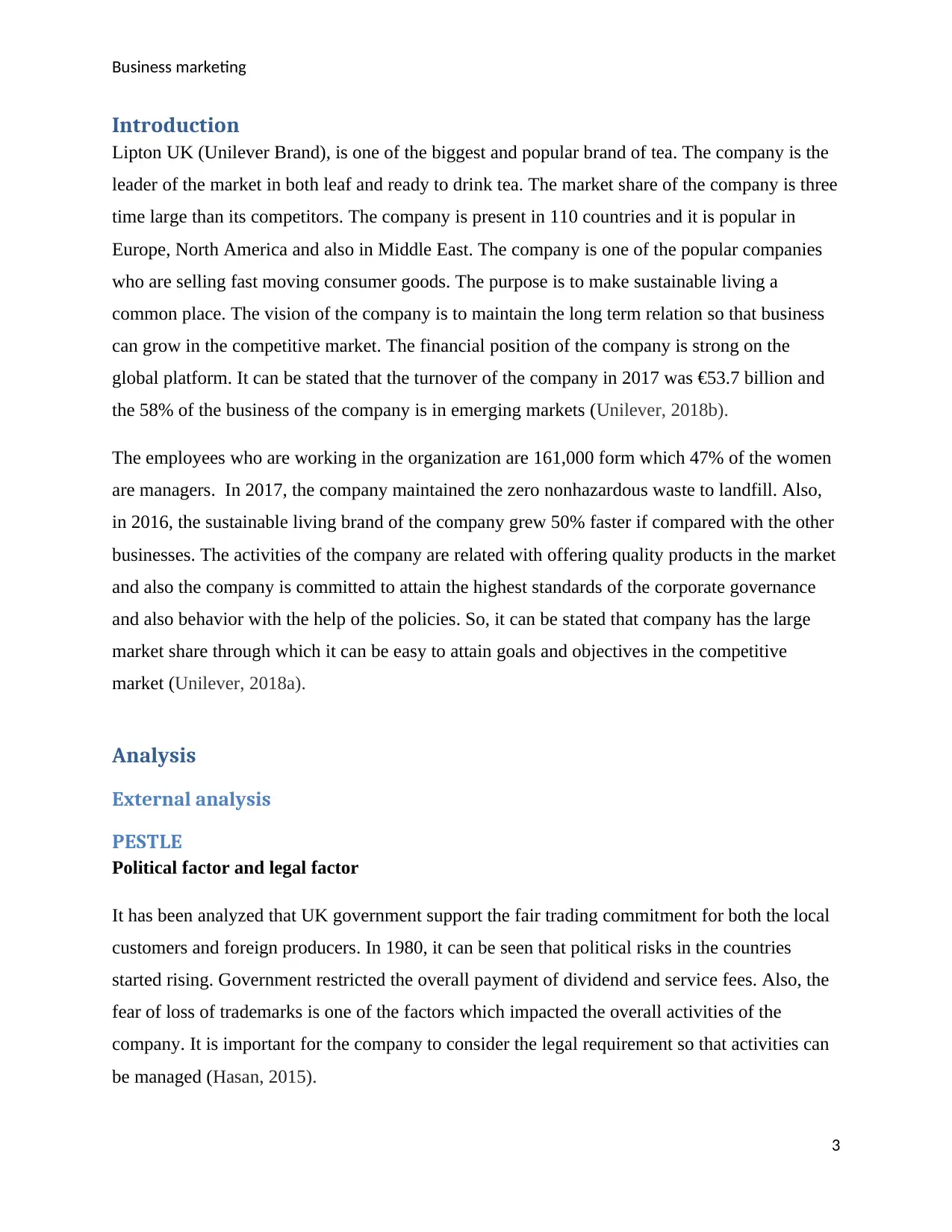
Business marketing
Introduction
Lipton UK (Unilever Brand), is one of the biggest and popular brand of tea. The company is the
leader of the market in both leaf and ready to drink tea. The market share of the company is three
time large than its competitors. The company is present in 110 countries and it is popular in
Europe, North America and also in Middle East. The company is one of the popular companies
who are selling fast moving consumer goods. The purpose is to make sustainable living a
common place. The vision of the company is to maintain the long term relation so that business
can grow in the competitive market. The financial position of the company is strong on the
global platform. It can be stated that the turnover of the company in 2017 was €53.7 billion and
the 58% of the business of the company is in emerging markets (Unilever, 2018b).
The employees who are working in the organization are 161,000 form which 47% of the women
are managers. In 2017, the company maintained the zero nonhazardous waste to landfill. Also,
in 2016, the sustainable living brand of the company grew 50% faster if compared with the other
businesses. The activities of the company are related with offering quality products in the market
and also the company is committed to attain the highest standards of the corporate governance
and also behavior with the help of the policies. So, it can be stated that company has the large
market share through which it can be easy to attain goals and objectives in the competitive
market (Unilever, 2018a).
Analysis
External analysis
PESTLE
Political factor and legal factor
It has been analyzed that UK government support the fair trading commitment for both the local
customers and foreign producers. In 1980, it can be seen that political risks in the countries
started rising. Government restricted the overall payment of dividend and service fees. Also, the
fear of loss of trademarks is one of the factors which impacted the overall activities of the
company. It is important for the company to consider the legal requirement so that activities can
be managed (Hasan, 2015).
3
Introduction
Lipton UK (Unilever Brand), is one of the biggest and popular brand of tea. The company is the
leader of the market in both leaf and ready to drink tea. The market share of the company is three
time large than its competitors. The company is present in 110 countries and it is popular in
Europe, North America and also in Middle East. The company is one of the popular companies
who are selling fast moving consumer goods. The purpose is to make sustainable living a
common place. The vision of the company is to maintain the long term relation so that business
can grow in the competitive market. The financial position of the company is strong on the
global platform. It can be stated that the turnover of the company in 2017 was €53.7 billion and
the 58% of the business of the company is in emerging markets (Unilever, 2018b).
The employees who are working in the organization are 161,000 form which 47% of the women
are managers. In 2017, the company maintained the zero nonhazardous waste to landfill. Also,
in 2016, the sustainable living brand of the company grew 50% faster if compared with the other
businesses. The activities of the company are related with offering quality products in the market
and also the company is committed to attain the highest standards of the corporate governance
and also behavior with the help of the policies. So, it can be stated that company has the large
market share through which it can be easy to attain goals and objectives in the competitive
market (Unilever, 2018a).
Analysis
External analysis
PESTLE
Political factor and legal factor
It has been analyzed that UK government support the fair trading commitment for both the local
customers and foreign producers. In 1980, it can be seen that political risks in the countries
started rising. Government restricted the overall payment of dividend and service fees. Also, the
fear of loss of trademarks is one of the factors which impacted the overall activities of the
company. It is important for the company to consider the legal requirement so that activities can
be managed (Hasan, 2015).
3
Secure Best Marks with AI Grader
Need help grading? Try our AI Grader for instant feedback on your assignments.
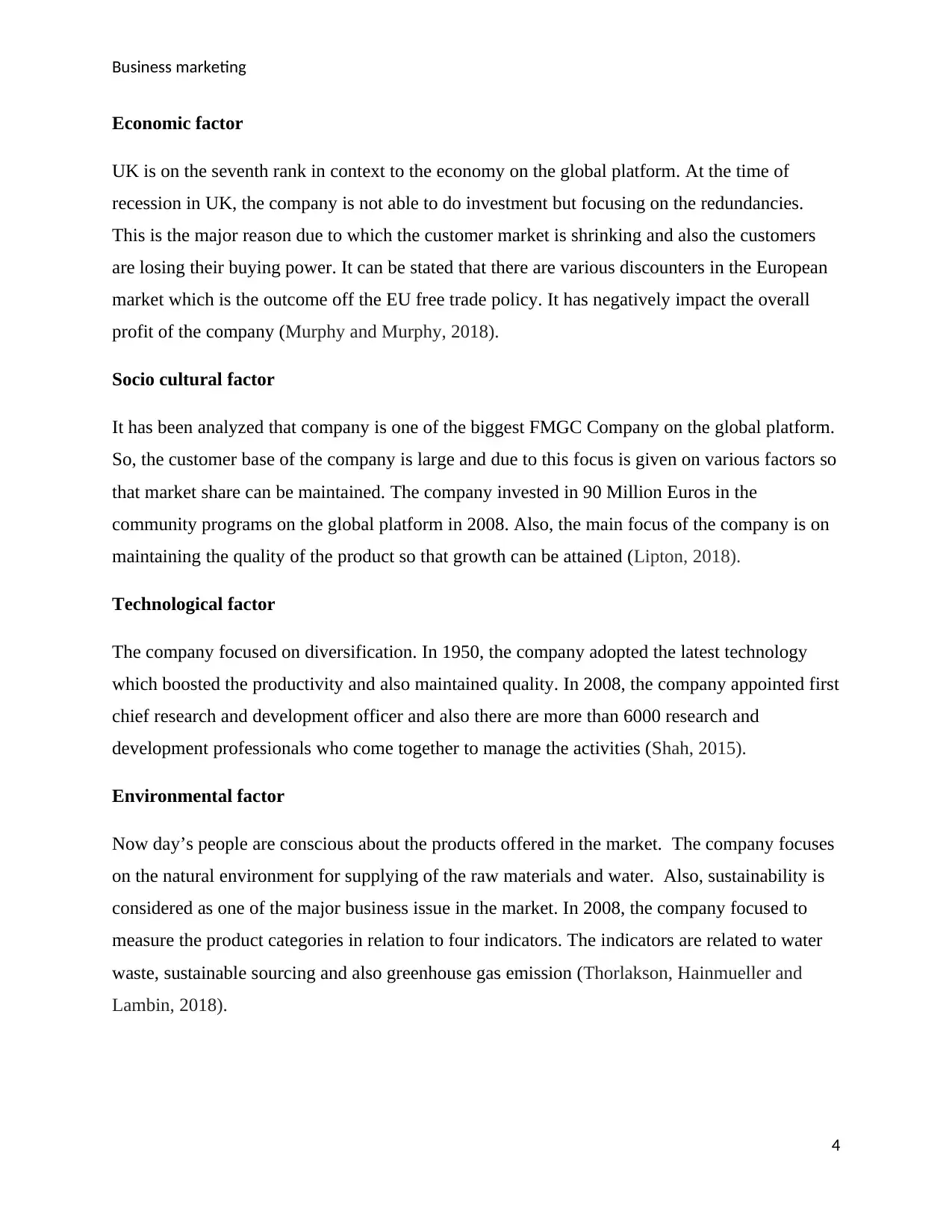
Business marketing
Economic factor
UK is on the seventh rank in context to the economy on the global platform. At the time of
recession in UK, the company is not able to do investment but focusing on the redundancies.
This is the major reason due to which the customer market is shrinking and also the customers
are losing their buying power. It can be stated that there are various discounters in the European
market which is the outcome off the EU free trade policy. It has negatively impact the overall
profit of the company (Murphy and Murphy, 2018).
Socio cultural factor
It has been analyzed that company is one of the biggest FMGC Company on the global platform.
So, the customer base of the company is large and due to this focus is given on various factors so
that market share can be maintained. The company invested in 90 Million Euros in the
community programs on the global platform in 2008. Also, the main focus of the company is on
maintaining the quality of the product so that growth can be attained (Lipton, 2018).
Technological factor
The company focused on diversification. In 1950, the company adopted the latest technology
which boosted the productivity and also maintained quality. In 2008, the company appointed first
chief research and development officer and also there are more than 6000 research and
development professionals who come together to manage the activities (Shah, 2015).
Environmental factor
Now day’s people are conscious about the products offered in the market. The company focuses
on the natural environment for supplying of the raw materials and water. Also, sustainability is
considered as one of the major business issue in the market. In 2008, the company focused to
measure the product categories in relation to four indicators. The indicators are related to water
waste, sustainable sourcing and also greenhouse gas emission (Thorlakson, Hainmueller and
Lambin, 2018).
4
Economic factor
UK is on the seventh rank in context to the economy on the global platform. At the time of
recession in UK, the company is not able to do investment but focusing on the redundancies.
This is the major reason due to which the customer market is shrinking and also the customers
are losing their buying power. It can be stated that there are various discounters in the European
market which is the outcome off the EU free trade policy. It has negatively impact the overall
profit of the company (Murphy and Murphy, 2018).
Socio cultural factor
It has been analyzed that company is one of the biggest FMGC Company on the global platform.
So, the customer base of the company is large and due to this focus is given on various factors so
that market share can be maintained. The company invested in 90 Million Euros in the
community programs on the global platform in 2008. Also, the main focus of the company is on
maintaining the quality of the product so that growth can be attained (Lipton, 2018).
Technological factor
The company focused on diversification. In 1950, the company adopted the latest technology
which boosted the productivity and also maintained quality. In 2008, the company appointed first
chief research and development officer and also there are more than 6000 research and
development professionals who come together to manage the activities (Shah, 2015).
Environmental factor
Now day’s people are conscious about the products offered in the market. The company focuses
on the natural environment for supplying of the raw materials and water. Also, sustainability is
considered as one of the major business issue in the market. In 2008, the company focused to
measure the product categories in relation to four indicators. The indicators are related to water
waste, sustainable sourcing and also greenhouse gas emission (Thorlakson, Hainmueller and
Lambin, 2018).
4
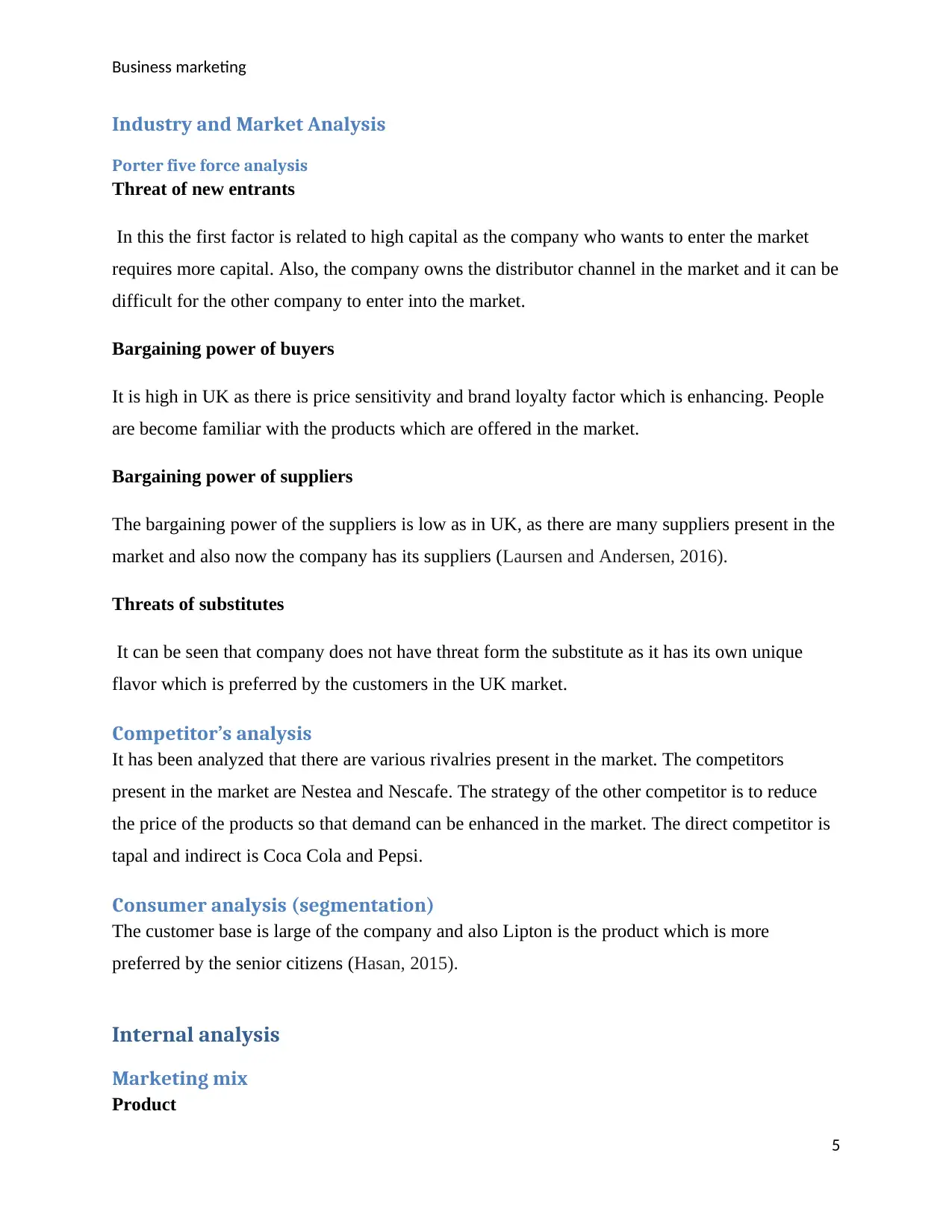
Business marketing
Industry and Market Analysis
Porter five force analysis
Threat of new entrants
In this the first factor is related to high capital as the company who wants to enter the market
requires more capital. Also, the company owns the distributor channel in the market and it can be
difficult for the other company to enter into the market.
Bargaining power of buyers
It is high in UK as there is price sensitivity and brand loyalty factor which is enhancing. People
are become familiar with the products which are offered in the market.
Bargaining power of suppliers
The bargaining power of the suppliers is low as in UK, as there are many suppliers present in the
market and also now the company has its suppliers (Laursen and Andersen, 2016).
Threats of substitutes
It can be seen that company does not have threat form the substitute as it has its own unique
flavor which is preferred by the customers in the UK market.
Competitor’s analysis
It has been analyzed that there are various rivalries present in the market. The competitors
present in the market are Nestea and Nescafe. The strategy of the other competitor is to reduce
the price of the products so that demand can be enhanced in the market. The direct competitor is
tapal and indirect is Coca Cola and Pepsi.
Consumer analysis (segmentation)
The customer base is large of the company and also Lipton is the product which is more
preferred by the senior citizens (Hasan, 2015).
Internal analysis
Marketing mix
Product
5
Industry and Market Analysis
Porter five force analysis
Threat of new entrants
In this the first factor is related to high capital as the company who wants to enter the market
requires more capital. Also, the company owns the distributor channel in the market and it can be
difficult for the other company to enter into the market.
Bargaining power of buyers
It is high in UK as there is price sensitivity and brand loyalty factor which is enhancing. People
are become familiar with the products which are offered in the market.
Bargaining power of suppliers
The bargaining power of the suppliers is low as in UK, as there are many suppliers present in the
market and also now the company has its suppliers (Laursen and Andersen, 2016).
Threats of substitutes
It can be seen that company does not have threat form the substitute as it has its own unique
flavor which is preferred by the customers in the UK market.
Competitor’s analysis
It has been analyzed that there are various rivalries present in the market. The competitors
present in the market are Nestea and Nescafe. The strategy of the other competitor is to reduce
the price of the products so that demand can be enhanced in the market. The direct competitor is
tapal and indirect is Coca Cola and Pepsi.
Consumer analysis (segmentation)
The customer base is large of the company and also Lipton is the product which is more
preferred by the senior citizens (Hasan, 2015).
Internal analysis
Marketing mix
Product
5
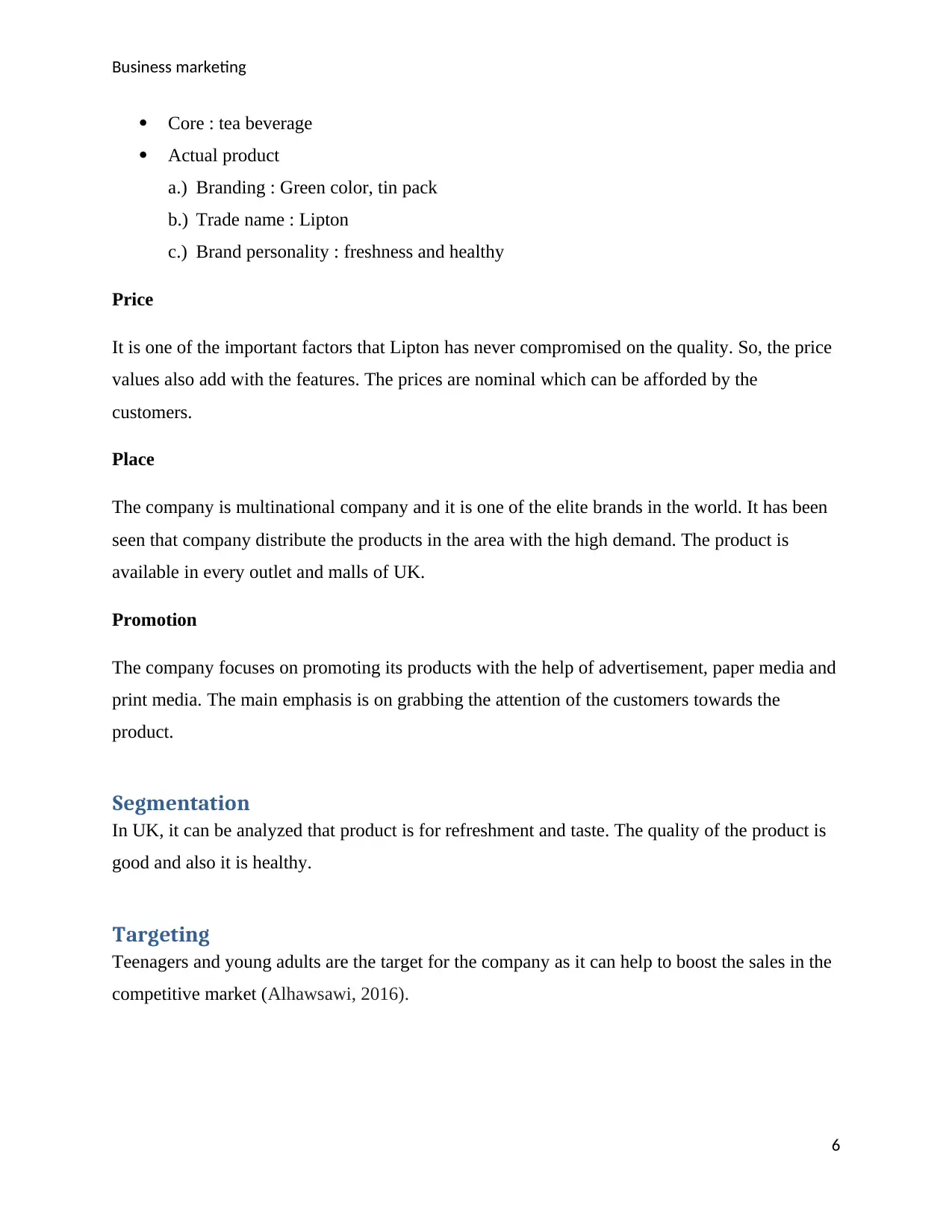
Business marketing
Core : tea beverage
Actual product
a.) Branding : Green color, tin pack
b.) Trade name : Lipton
c.) Brand personality : freshness and healthy
Price
It is one of the important factors that Lipton has never compromised on the quality. So, the price
values also add with the features. The prices are nominal which can be afforded by the
customers.
Place
The company is multinational company and it is one of the elite brands in the world. It has been
seen that company distribute the products in the area with the high demand. The product is
available in every outlet and malls of UK.
Promotion
The company focuses on promoting its products with the help of advertisement, paper media and
print media. The main emphasis is on grabbing the attention of the customers towards the
product.
Segmentation
In UK, it can be analyzed that product is for refreshment and taste. The quality of the product is
good and also it is healthy.
Targeting
Teenagers and young adults are the target for the company as it can help to boost the sales in the
competitive market (Alhawsawi, 2016).
6
Core : tea beverage
Actual product
a.) Branding : Green color, tin pack
b.) Trade name : Lipton
c.) Brand personality : freshness and healthy
Price
It is one of the important factors that Lipton has never compromised on the quality. So, the price
values also add with the features. The prices are nominal which can be afforded by the
customers.
Place
The company is multinational company and it is one of the elite brands in the world. It has been
seen that company distribute the products in the area with the high demand. The product is
available in every outlet and malls of UK.
Promotion
The company focuses on promoting its products with the help of advertisement, paper media and
print media. The main emphasis is on grabbing the attention of the customers towards the
product.
Segmentation
In UK, it can be analyzed that product is for refreshment and taste. The quality of the product is
good and also it is healthy.
Targeting
Teenagers and young adults are the target for the company as it can help to boost the sales in the
competitive market (Alhawsawi, 2016).
6
Paraphrase This Document
Need a fresh take? Get an instant paraphrase of this document with our AI Paraphraser
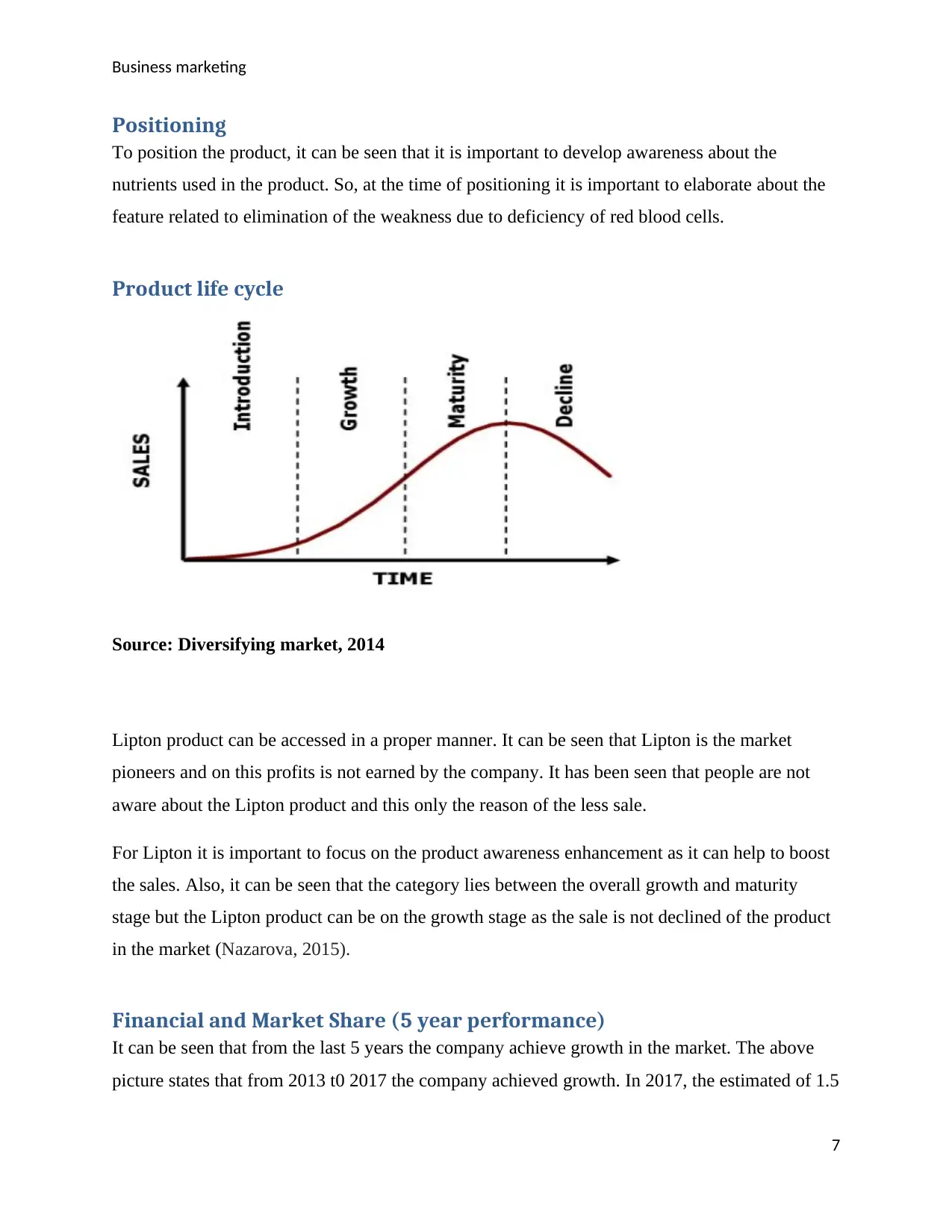
Business marketing
Positioning
To position the product, it can be seen that it is important to develop awareness about the
nutrients used in the product. So, at the time of positioning it is important to elaborate about the
feature related to elimination of the weakness due to deficiency of red blood cells.
Product life cycle
Source: Diversifying market, 2014
Lipton product can be accessed in a proper manner. It can be seen that Lipton is the market
pioneers and on this profits is not earned by the company. It has been seen that people are not
aware about the Lipton product and this only the reason of the less sale.
For Lipton it is important to focus on the product awareness enhancement as it can help to boost
the sales. Also, it can be seen that the category lies between the overall growth and maturity
stage but the Lipton product can be on the growth stage as the sale is not declined of the product
in the market (Nazarova, 2015).
Financial and Market Share (5 year performance)
It can be seen that from the last 5 years the company achieve growth in the market. The above
picture states that from 2013 t0 2017 the company achieved growth. In 2017, the estimated of 1.5
7
Positioning
To position the product, it can be seen that it is important to develop awareness about the
nutrients used in the product. So, at the time of positioning it is important to elaborate about the
feature related to elimination of the weakness due to deficiency of red blood cells.
Product life cycle
Source: Diversifying market, 2014
Lipton product can be accessed in a proper manner. It can be seen that Lipton is the market
pioneers and on this profits is not earned by the company. It has been seen that people are not
aware about the Lipton product and this only the reason of the less sale.
For Lipton it is important to focus on the product awareness enhancement as it can help to boost
the sales. Also, it can be seen that the category lies between the overall growth and maturity
stage but the Lipton product can be on the growth stage as the sale is not declined of the product
in the market (Nazarova, 2015).
Financial and Market Share (5 year performance)
It can be seen that from the last 5 years the company achieve growth in the market. The above
picture states that from 2013 t0 2017 the company achieved growth. In 2017, the estimated of 1.5
7
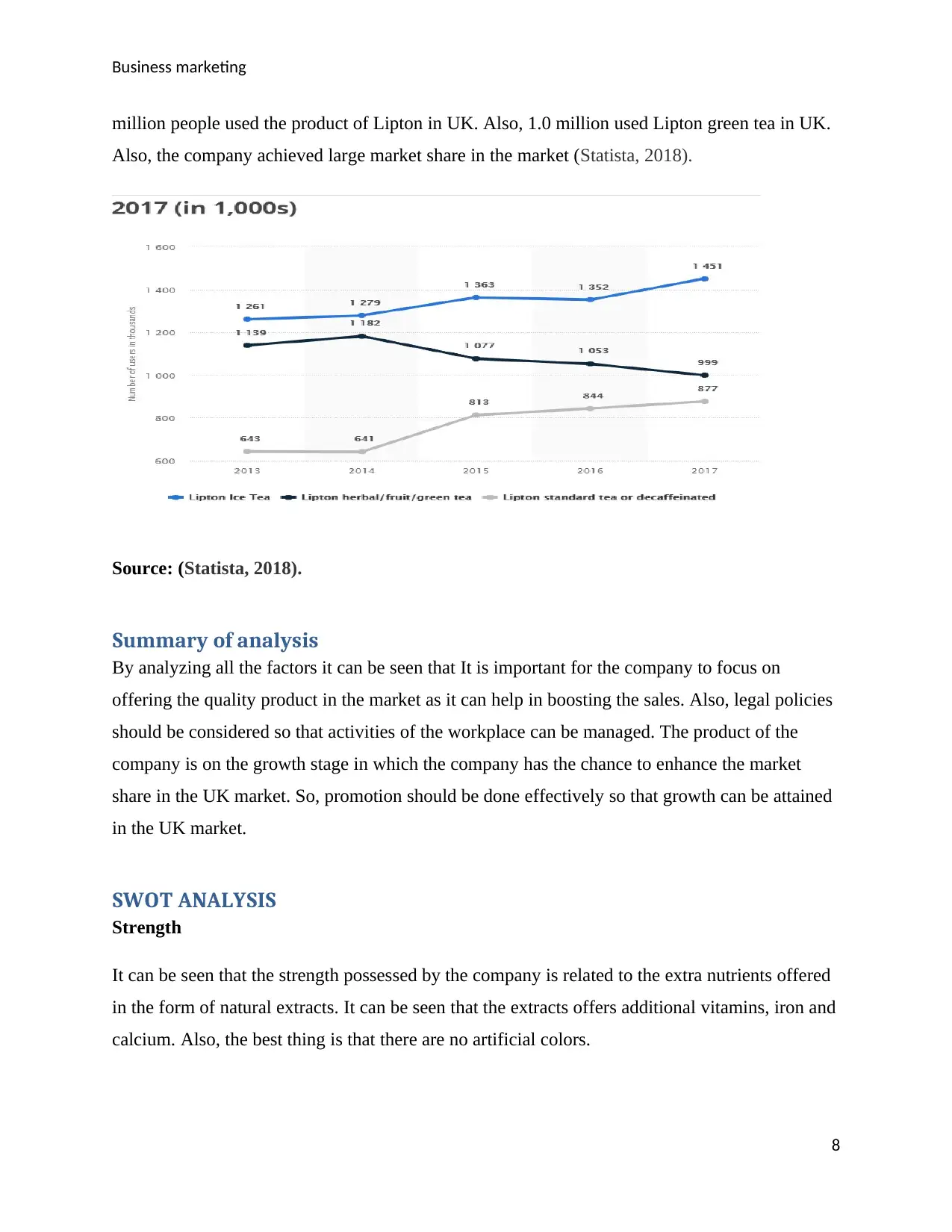
Business marketing
million people used the product of Lipton in UK. Also, 1.0 million used Lipton green tea in UK.
Also, the company achieved large market share in the market (Statista, 2018).
Source: (Statista, 2018).
Summary of analysis
By analyzing all the factors it can be seen that It is important for the company to focus on
offering the quality product in the market as it can help in boosting the sales. Also, legal policies
should be considered so that activities of the workplace can be managed. The product of the
company is on the growth stage in which the company has the chance to enhance the market
share in the UK market. So, promotion should be done effectively so that growth can be attained
in the UK market.
SWOT ANALYSIS
Strength
It can be seen that the strength possessed by the company is related to the extra nutrients offered
in the form of natural extracts. It can be seen that the extracts offers additional vitamins, iron and
calcium. Also, the best thing is that there are no artificial colors.
8
million people used the product of Lipton in UK. Also, 1.0 million used Lipton green tea in UK.
Also, the company achieved large market share in the market (Statista, 2018).
Source: (Statista, 2018).
Summary of analysis
By analyzing all the factors it can be seen that It is important for the company to focus on
offering the quality product in the market as it can help in boosting the sales. Also, legal policies
should be considered so that activities of the workplace can be managed. The product of the
company is on the growth stage in which the company has the chance to enhance the market
share in the UK market. So, promotion should be done effectively so that growth can be attained
in the UK market.
SWOT ANALYSIS
Strength
It can be seen that the strength possessed by the company is related to the extra nutrients offered
in the form of natural extracts. It can be seen that the extracts offers additional vitamins, iron and
calcium. Also, the best thing is that there are no artificial colors.
8
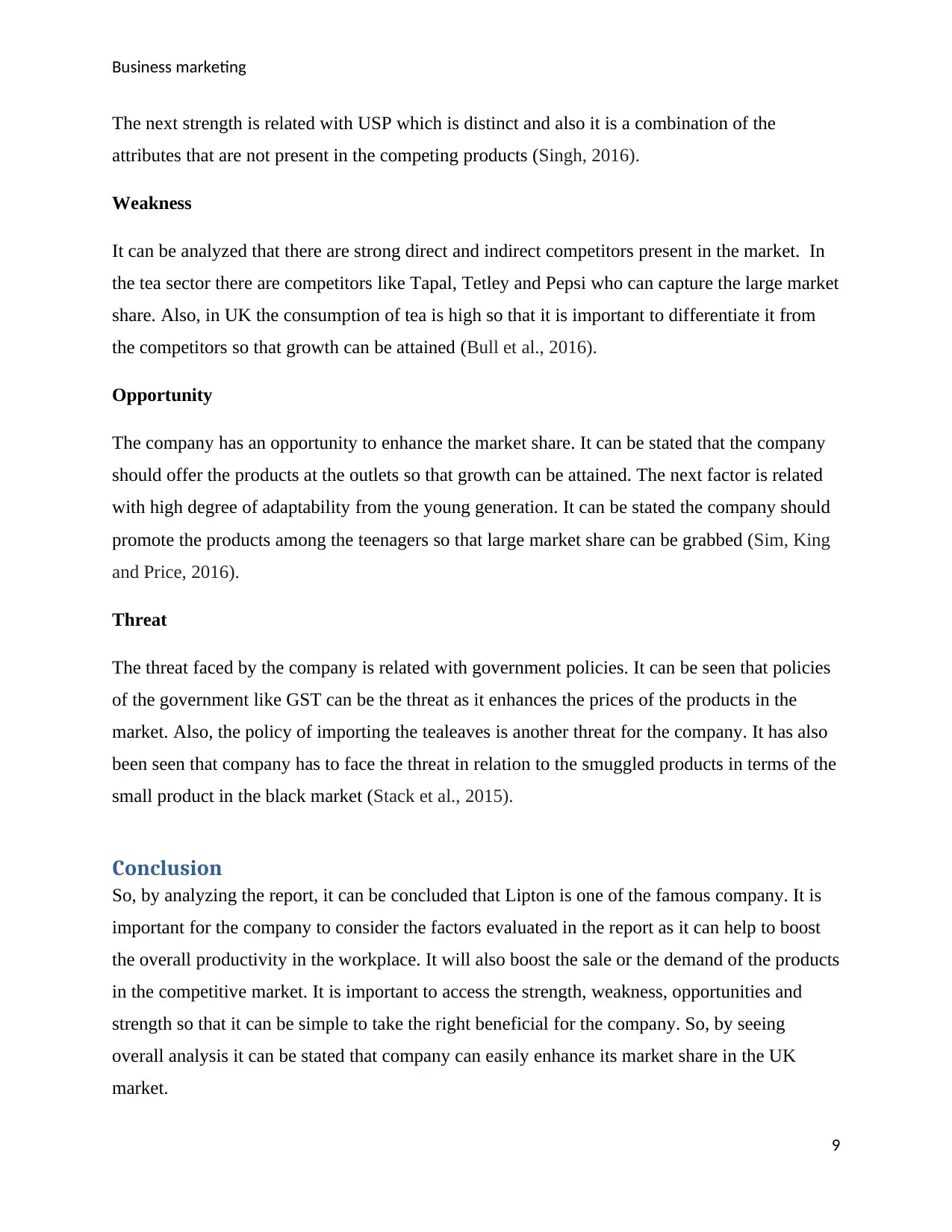
Business marketing
The next strength is related with USP which is distinct and also it is a combination of the
attributes that are not present in the competing products (Singh, 2016).
Weakness
It can be analyzed that there are strong direct and indirect competitors present in the market. In
the tea sector there are competitors like Tapal, Tetley and Pepsi who can capture the large market
share. Also, in UK the consumption of tea is high so that it is important to differentiate it from
the competitors so that growth can be attained (Bull et al., 2016).
Opportunity
The company has an opportunity to enhance the market share. It can be stated that the company
should offer the products at the outlets so that growth can be attained. The next factor is related
with high degree of adaptability from the young generation. It can be stated the company should
promote the products among the teenagers so that large market share can be grabbed (Sim, King
and Price, 2016).
Threat
The threat faced by the company is related with government policies. It can be seen that policies
of the government like GST can be the threat as it enhances the prices of the products in the
market. Also, the policy of importing the tealeaves is another threat for the company. It has also
been seen that company has to face the threat in relation to the smuggled products in terms of the
small product in the black market (Stack et al., 2015).
Conclusion
So, by analyzing the report, it can be concluded that Lipton is one of the famous company. It is
important for the company to consider the factors evaluated in the report as it can help to boost
the overall productivity in the workplace. It will also boost the sale or the demand of the products
in the competitive market. It is important to access the strength, weakness, opportunities and
strength so that it can be simple to take the right beneficial for the company. So, by seeing
overall analysis it can be stated that company can easily enhance its market share in the UK
market.
9
The next strength is related with USP which is distinct and also it is a combination of the
attributes that are not present in the competing products (Singh, 2016).
Weakness
It can be analyzed that there are strong direct and indirect competitors present in the market. In
the tea sector there are competitors like Tapal, Tetley and Pepsi who can capture the large market
share. Also, in UK the consumption of tea is high so that it is important to differentiate it from
the competitors so that growth can be attained (Bull et al., 2016).
Opportunity
The company has an opportunity to enhance the market share. It can be stated that the company
should offer the products at the outlets so that growth can be attained. The next factor is related
with high degree of adaptability from the young generation. It can be stated the company should
promote the products among the teenagers so that large market share can be grabbed (Sim, King
and Price, 2016).
Threat
The threat faced by the company is related with government policies. It can be seen that policies
of the government like GST can be the threat as it enhances the prices of the products in the
market. Also, the policy of importing the tealeaves is another threat for the company. It has also
been seen that company has to face the threat in relation to the smuggled products in terms of the
small product in the black market (Stack et al., 2015).
Conclusion
So, by analyzing the report, it can be concluded that Lipton is one of the famous company. It is
important for the company to consider the factors evaluated in the report as it can help to boost
the overall productivity in the workplace. It will also boost the sale or the demand of the products
in the competitive market. It is important to access the strength, weakness, opportunities and
strength so that it can be simple to take the right beneficial for the company. So, by seeing
overall analysis it can be stated that company can easily enhance its market share in the UK
market.
9
Secure Best Marks with AI Grader
Need help grading? Try our AI Grader for instant feedback on your assignments.
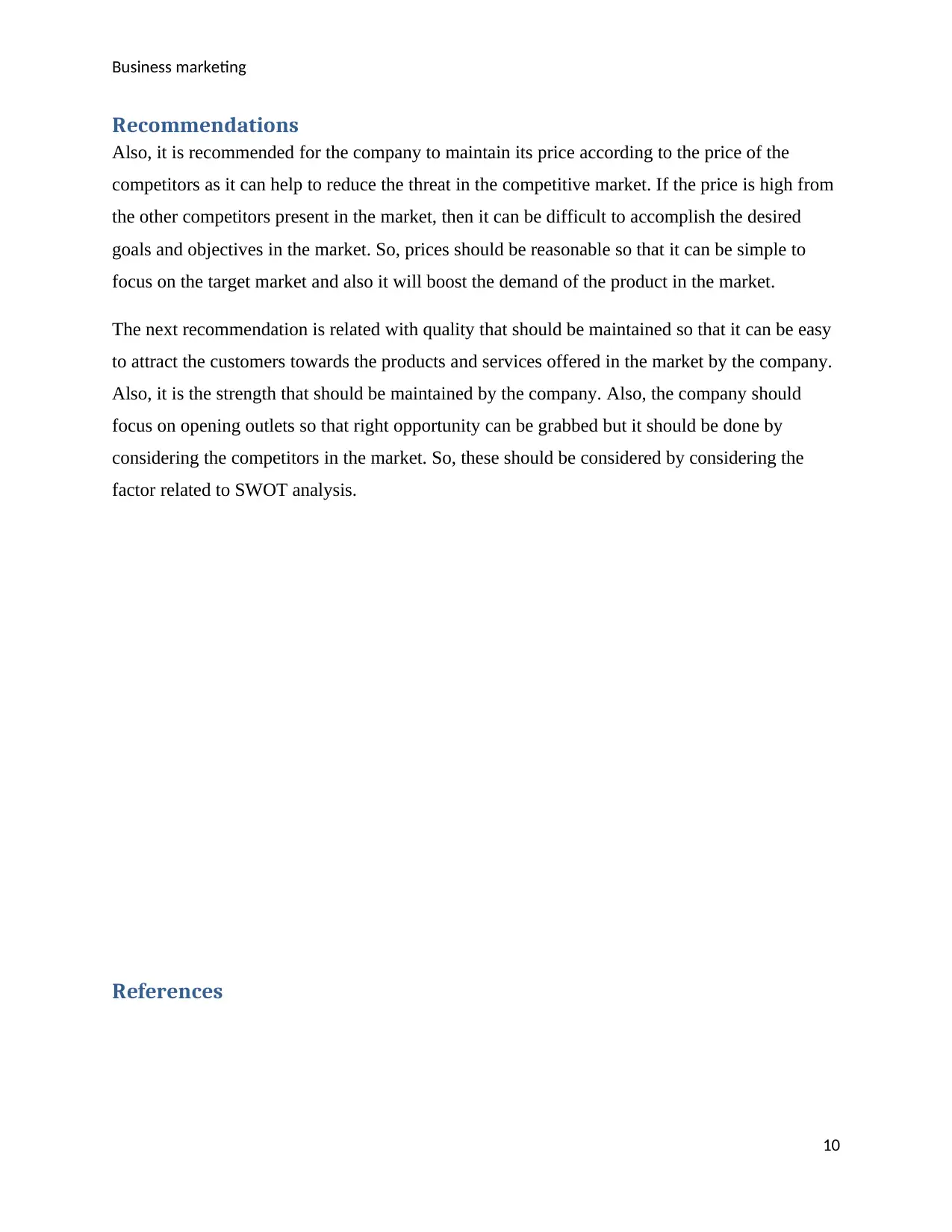
Business marketing
Recommendations
Also, it is recommended for the company to maintain its price according to the price of the
competitors as it can help to reduce the threat in the competitive market. If the price is high from
the other competitors present in the market, then it can be difficult to accomplish the desired
goals and objectives in the market. So, prices should be reasonable so that it can be simple to
focus on the target market and also it will boost the demand of the product in the market.
The next recommendation is related with quality that should be maintained so that it can be easy
to attract the customers towards the products and services offered in the market by the company.
Also, it is the strength that should be maintained by the company. Also, the company should
focus on opening outlets so that right opportunity can be grabbed but it should be done by
considering the competitors in the market. So, these should be considered by considering the
factor related to SWOT analysis.
References
10
Recommendations
Also, it is recommended for the company to maintain its price according to the price of the
competitors as it can help to reduce the threat in the competitive market. If the price is high from
the other competitors present in the market, then it can be difficult to accomplish the desired
goals and objectives in the market. So, prices should be reasonable so that it can be simple to
focus on the target market and also it will boost the demand of the product in the market.
The next recommendation is related with quality that should be maintained so that it can be easy
to attract the customers towards the products and services offered in the market by the company.
Also, it is the strength that should be maintained by the company. Also, the company should
focus on opening outlets so that right opportunity can be grabbed but it should be done by
considering the competitors in the market. So, these should be considered by considering the
factor related to SWOT analysis.
References
10
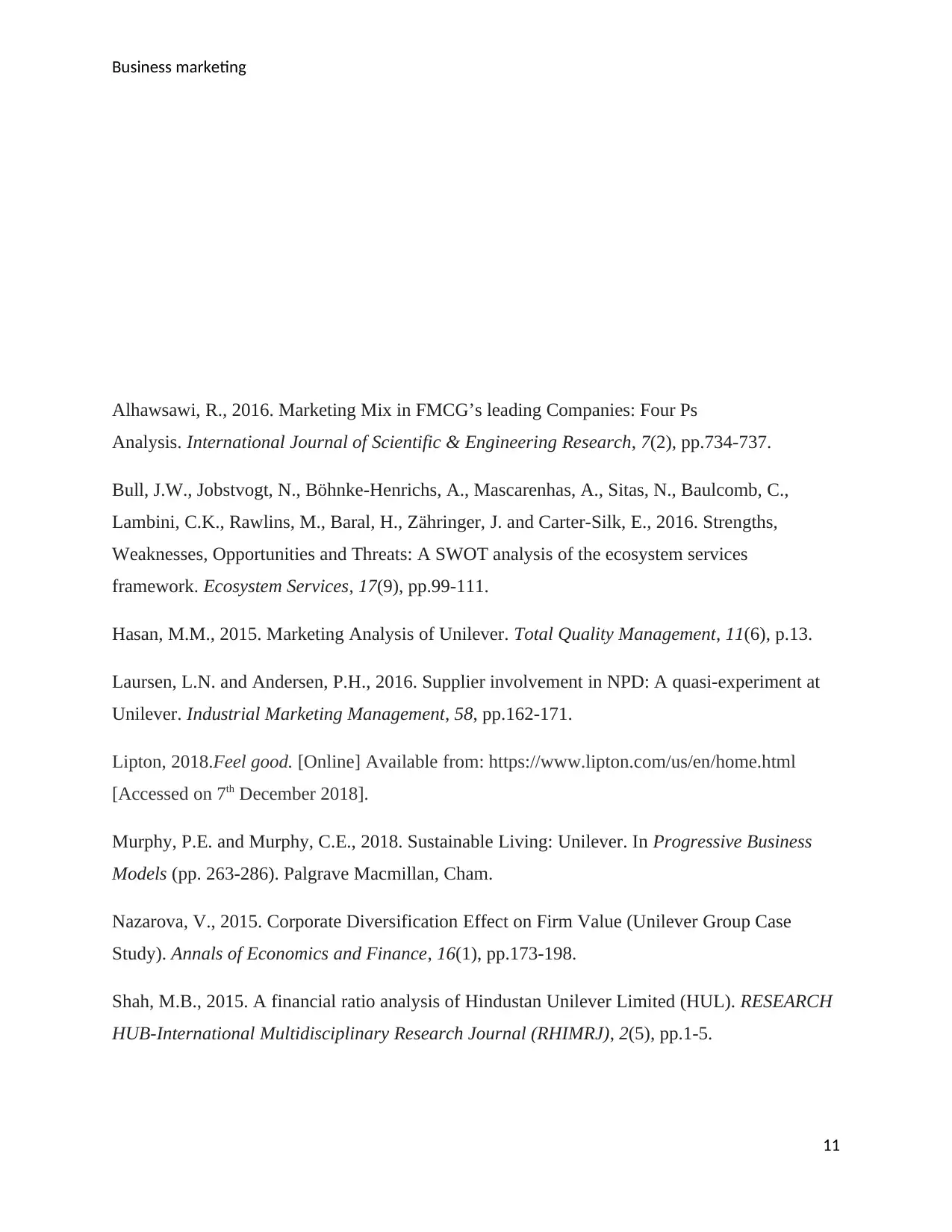
Business marketing
Alhawsawi, R., 2016. Marketing Mix in FMCG’s leading Companies: Four Ps
Analysis. International Journal of Scientific & Engineering Research, 7(2), pp.734-737.
Bull, J.W., Jobstvogt, N., Böhnke-Henrichs, A., Mascarenhas, A., Sitas, N., Baulcomb, C.,
Lambini, C.K., Rawlins, M., Baral, H., Zähringer, J. and Carter-Silk, E., 2016. Strengths,
Weaknesses, Opportunities and Threats: A SWOT analysis of the ecosystem services
framework. Ecosystem Services, 17(9), pp.99-111.
Hasan, M.M., 2015. Marketing Analysis of Unilever. Total Quality Management, 11(6), p.13.
Laursen, L.N. and Andersen, P.H., 2016. Supplier involvement in NPD: A quasi-experiment at
Unilever. Industrial Marketing Management, 58, pp.162-171.
Lipton, 2018.Feel good. [Online] Available from: https://www.lipton.com/us/en/home.html
[Accessed on 7th December 2018].
Murphy, P.E. and Murphy, C.E., 2018. Sustainable Living: Unilever. In Progressive Business
Models (pp. 263-286). Palgrave Macmillan, Cham.
Nazarova, V., 2015. Corporate Diversification Effect on Firm Value (Unilever Group Case
Study). Annals of Economics and Finance, 16(1), pp.173-198.
Shah, M.B., 2015. A financial ratio analysis of Hindustan Unilever Limited (HUL). RESEARCH
HUB-International Multidisciplinary Research Journal (RHIMRJ), 2(5), pp.1-5.
11
Alhawsawi, R., 2016. Marketing Mix in FMCG’s leading Companies: Four Ps
Analysis. International Journal of Scientific & Engineering Research, 7(2), pp.734-737.
Bull, J.W., Jobstvogt, N., Böhnke-Henrichs, A., Mascarenhas, A., Sitas, N., Baulcomb, C.,
Lambini, C.K., Rawlins, M., Baral, H., Zähringer, J. and Carter-Silk, E., 2016. Strengths,
Weaknesses, Opportunities and Threats: A SWOT analysis of the ecosystem services
framework. Ecosystem Services, 17(9), pp.99-111.
Hasan, M.M., 2015. Marketing Analysis of Unilever. Total Quality Management, 11(6), p.13.
Laursen, L.N. and Andersen, P.H., 2016. Supplier involvement in NPD: A quasi-experiment at
Unilever. Industrial Marketing Management, 58, pp.162-171.
Lipton, 2018.Feel good. [Online] Available from: https://www.lipton.com/us/en/home.html
[Accessed on 7th December 2018].
Murphy, P.E. and Murphy, C.E., 2018. Sustainable Living: Unilever. In Progressive Business
Models (pp. 263-286). Palgrave Macmillan, Cham.
Nazarova, V., 2015. Corporate Diversification Effect on Firm Value (Unilever Group Case
Study). Annals of Economics and Finance, 16(1), pp.173-198.
Shah, M.B., 2015. A financial ratio analysis of Hindustan Unilever Limited (HUL). RESEARCH
HUB-International Multidisciplinary Research Journal (RHIMRJ), 2(5), pp.1-5.
11
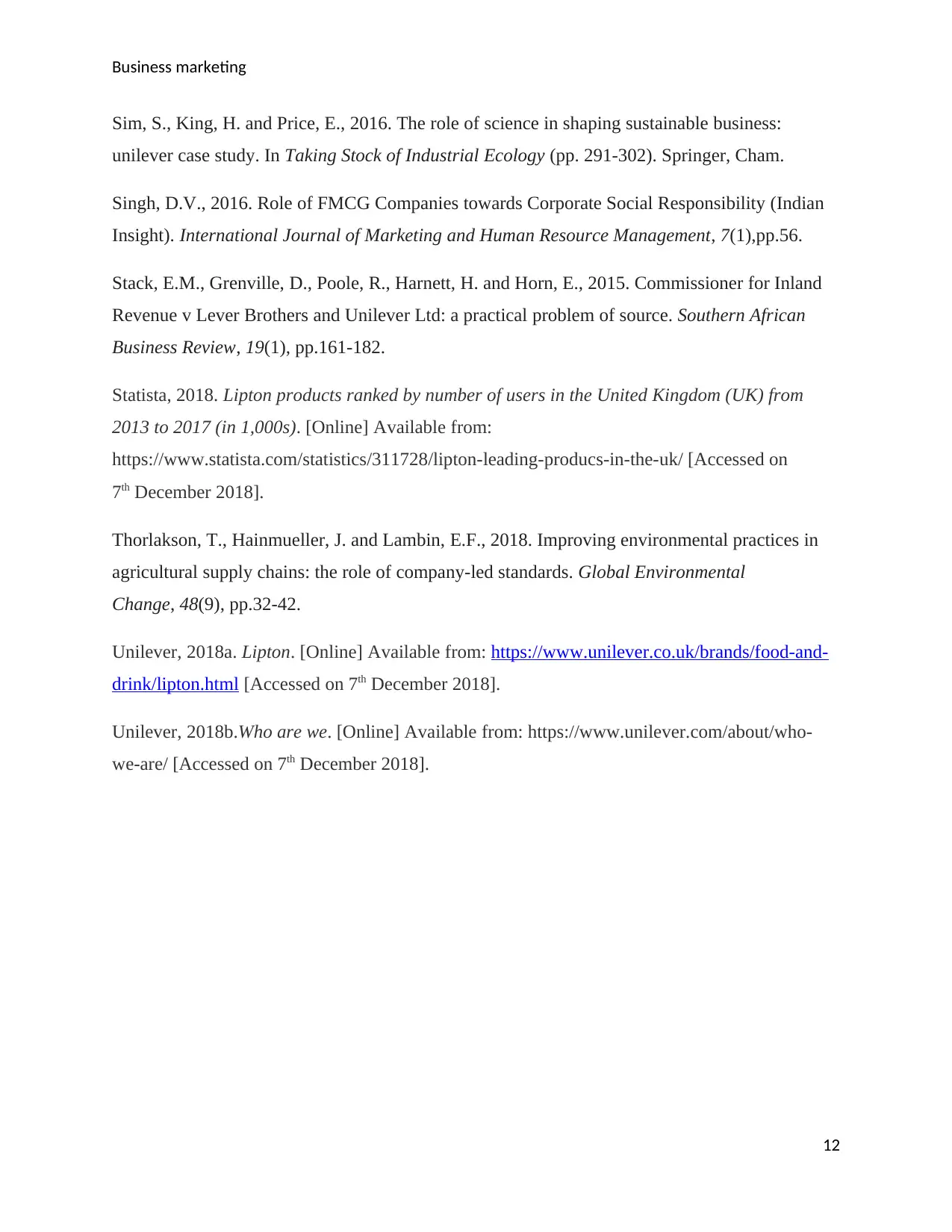
Business marketing
Sim, S., King, H. and Price, E., 2016. The role of science in shaping sustainable business:
unilever case study. In Taking Stock of Industrial Ecology (pp. 291-302). Springer, Cham.
Singh, D.V., 2016. Role of FMCG Companies towards Corporate Social Responsibility (Indian
Insight). International Journal of Marketing and Human Resource Management, 7(1),pp.56.
Stack, E.M., Grenville, D., Poole, R., Harnett, H. and Horn, E., 2015. Commissioner for Inland
Revenue v Lever Brothers and Unilever Ltd: a practical problem of source. Southern African
Business Review, 19(1), pp.161-182.
Statista, 2018. Lipton products ranked by number of users in the United Kingdom (UK) from
2013 to 2017 (in 1,000s). [Online] Available from:
https://www.statista.com/statistics/311728/lipton-leading-producs-in-the-uk/ [Accessed on
7th December 2018].
Thorlakson, T., Hainmueller, J. and Lambin, E.F., 2018. Improving environmental practices in
agricultural supply chains: the role of company-led standards. Global Environmental
Change, 48(9), pp.32-42.
Unilever, 2018a. Lipton. [Online] Available from: https://www.unilever.co.uk/brands/food-and-
drink/lipton.html [Accessed on 7th December 2018].
Unilever, 2018b.Who are we. [Online] Available from: https://www.unilever.com/about/who-
we-are/ [Accessed on 7th December 2018].
12
Sim, S., King, H. and Price, E., 2016. The role of science in shaping sustainable business:
unilever case study. In Taking Stock of Industrial Ecology (pp. 291-302). Springer, Cham.
Singh, D.V., 2016. Role of FMCG Companies towards Corporate Social Responsibility (Indian
Insight). International Journal of Marketing and Human Resource Management, 7(1),pp.56.
Stack, E.M., Grenville, D., Poole, R., Harnett, H. and Horn, E., 2015. Commissioner for Inland
Revenue v Lever Brothers and Unilever Ltd: a practical problem of source. Southern African
Business Review, 19(1), pp.161-182.
Statista, 2018. Lipton products ranked by number of users in the United Kingdom (UK) from
2013 to 2017 (in 1,000s). [Online] Available from:
https://www.statista.com/statistics/311728/lipton-leading-producs-in-the-uk/ [Accessed on
7th December 2018].
Thorlakson, T., Hainmueller, J. and Lambin, E.F., 2018. Improving environmental practices in
agricultural supply chains: the role of company-led standards. Global Environmental
Change, 48(9), pp.32-42.
Unilever, 2018a. Lipton. [Online] Available from: https://www.unilever.co.uk/brands/food-and-
drink/lipton.html [Accessed on 7th December 2018].
Unilever, 2018b.Who are we. [Online] Available from: https://www.unilever.com/about/who-
we-are/ [Accessed on 7th December 2018].
12
1 out of 13
Related Documents
Your All-in-One AI-Powered Toolkit for Academic Success.
+13062052269
info@desklib.com
Available 24*7 on WhatsApp / Email
![[object Object]](/_next/static/media/star-bottom.7253800d.svg)
Unlock your academic potential
© 2024 | Zucol Services PVT LTD | All rights reserved.





